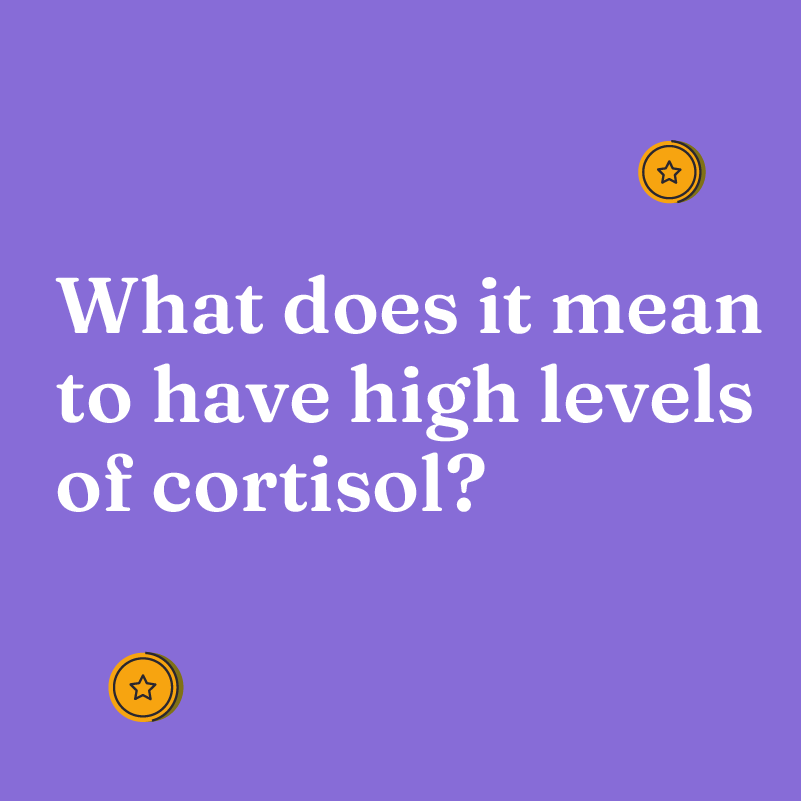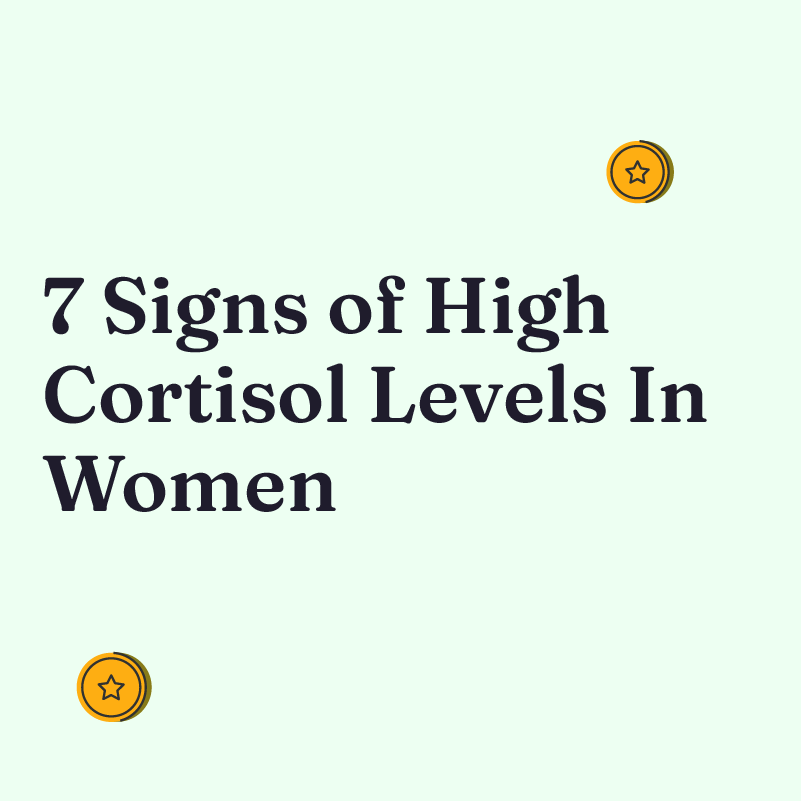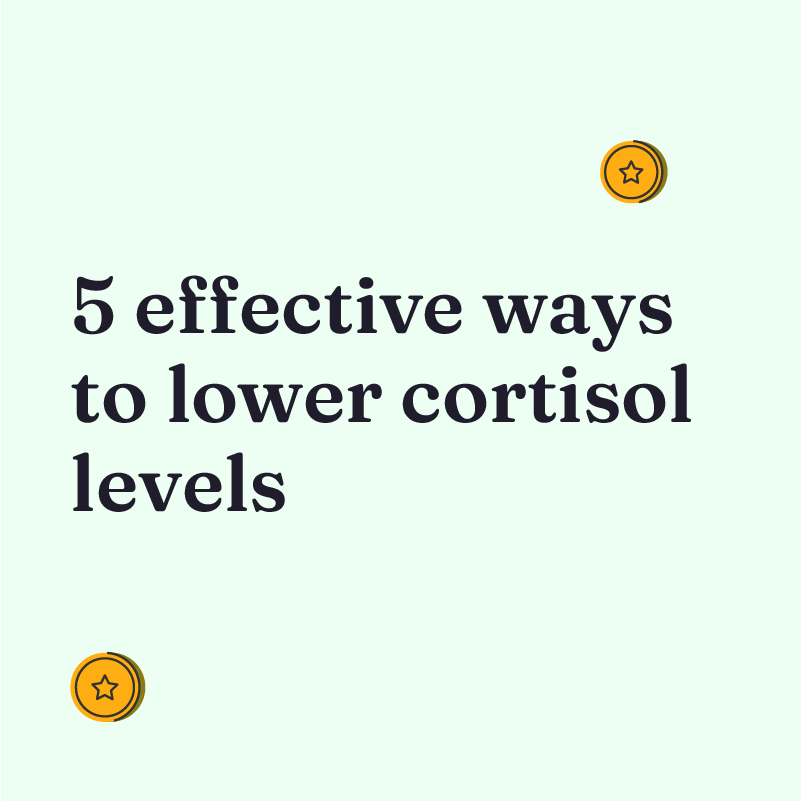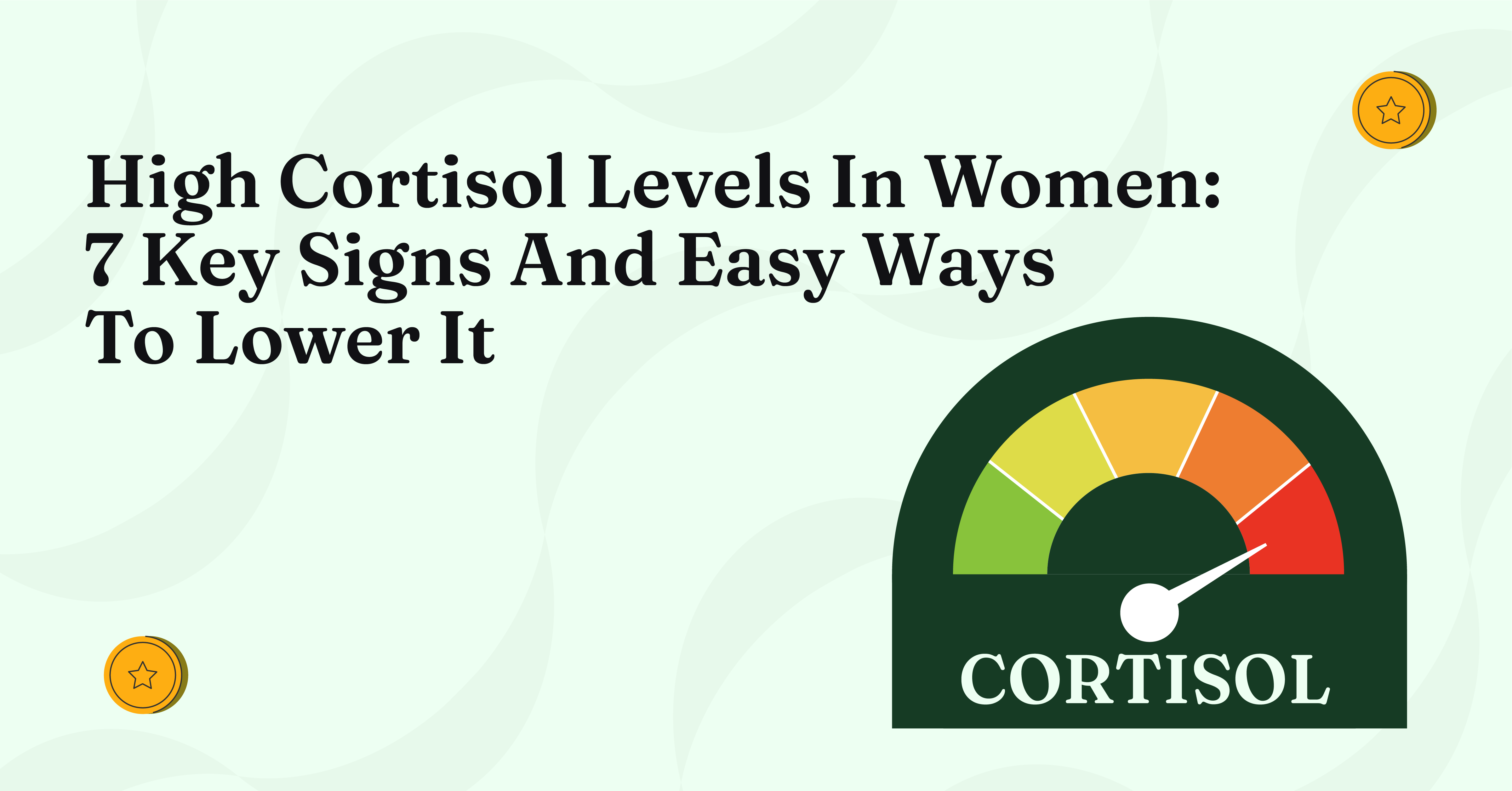Cortisol, often called the “stress hormone” plays an important role in our body’s response to stress. However, when levels of this hormone are too high, it can lead to a range of health issues. This is particularly relevant for women, who may experience unique signs of high cortisol levels due to their biological makeup.
In this article, we will discuss cortisol’s role in our bodies, its effects on women, and how to manage high levels.

What exactly is cortisol?
Cortisol is a steroid hormone that your adrenal glands—the endocrine glands on top of your kidneys—produce and release. It’s called the “stress hormone” because it’s released into the body in response to stress.
However, it plays a huge role in other bodily functions, aside from trying to control stress.
What does cortisol do?
Despite its bad rap, cortisol is not a “bad” hormone. It’s very important for our day-to-day survival.
1. Cortisol helps you wake up in the morning: It’s normal for cortisol levels to be higher. This helps you feel alert and ready to start the day.
2. Cortisol keeps your blood sugar in check: It helps maintain steady levels of sugar in your blood. This provides your body with a consistent stream of energy throughout the day.
3. Cortisol helps you respond to danger: In response to a threat, cortisol can give a quick burst of energy. This is part of the “fight or flight” response that helps you react to dangerous situations.
4. Cortisol supports your immune system: It helps regulate your body’s immune response. However, if cortisol levels are high for too long, it can weaken the immune system.
In general, it helps maintain homeostasis by regulating a wide range of processes throughout the body, including metabolism and the immune response.
Examples Of Cortisol’s Role In Everyday Life
Here are some everyday scenarios that cortisol can play a huge role in
– Pregnancy: When you’re pregnant, your body makes more cortisol. This is normal and helps the baby grow. But too much stress and cortisol can be harmful, so it’s important to keep stress under control.
– Menopause: Menopause causes big hormone changes that can also affect cortisol levels. This shows why it’s important to manage stress and keep hormones balanced during menopause.
– Breastfeeding: Looking after a newborn and breastfeeding can make cortisol levels go up. This is a normal response to stress, but finding ways to manage stress is important for both the mother’s and the baby’s health.
– Menstrual Cycle: Stress and the hormone cortisol can change when your period happens and what it’s like. It’s important to manage stress well.
– Experiencing a stressful event: When you’re stressed, your body makes more cortisol. This is like your body’s way of giving you a quick burst of energy to deal with the stress. But, it’s important to take time to chill out afterwards.

What does it mean to have high levels of cortisol?
High cortisol levels can significantly affect your health and daily life. Normally, cortisol levels follow a diurnal pattern, which means they are highest in the early morning to help you wake up and lowest at night to help you wind down for sleep.
However, if you have persistently high cortisol levels, this natural rhythm can be disrupted. You might feel stressed and tired at night but have trouble falling or staying asleep, or feel unusually tired during the day. Over time, this can lead to chronic fatigue, mood swings, and difficulty concentrating or making decisions.
It’s also worth noting that the normal ranges for cortisol can vary. While most people have cortisol levels between 10 to 20 mcg/dL in the morning and 3 to 10 mcg/dL in the afternoon, these ranges can differ based on the individual, the specific lab’s reference range, and even the time of year.
It’s important to work with a healthcare provider to interpret your cortisol test results. They can help you understand what your results mean for you and guide you on the next steps.

7 Symptoms of High Cortisol Levels In Women
High cortisol levels can manifest in various ways, often intertwining with and amplifying other stressors in your daily life. Some of these include:
1. You have severe fatigue
Constantly feeling tired, no matter of how much you rest, can be a sign of high cortisol. This isn’t just the usual tiredness from a night of poor sleep, but a deep, unrelenting fatigue that significantly impacts your ability to function normally.
2. You have trouble sleeping
High cortisol levels can disrupt your body’s natural sleep-wake cycle, making it hard to fall asleep or stay asleep. You might find yourself feeling wide awake at night, or waking up frequently, and then feel exhausted during the day.
3. You are gaining weight
Unexplained weight gain, especially around the abdomen, can be a sign of high cortisol. Cortisol can increase your appetite and signal your body to store fat, particularly in the belly area where more cortisol receptors are located.
4. You’re experiencing mood swings
If you’re experiencing high cortisol, you might find your moods are more unpredictable than usual. You could feel fine one moment and then suddenly feel very down, anxious, or irritable.
5. Your sweat stinks
If you notice a persistent, unusual change in body odour, it could be a sign of high cortisol levels. This isn’t the same as the temporary change in sweat smell that can happen after eating certain foods or because of certain medications, but a consistent, noticeable difference in how your sweat smells.
6. Your skin is experiencing changes
High cortisol can lead to changes in your skin, like more frequent breakouts, or skin that’s thinner, more sensitive, or heals more slowly. This is because cortisol can increase oil production in your skin and interfere with wound healing.
7. You feel bloated
Bloating can be a sign of high cortisol levels. If you’re experiencing this symptom, it’s important to speak with a healthcare provider. They can help you identify the cause and guide you on the next steps.
While it’s normal for everyone to experience stress at times, chronic high cortisol levels can lead to a range of serious health issues. Women need to be aware of these signs, as they can have a profound impact on their hormonal balance and reproductive health.
Effects of high cortisol levels on women
High cortisol levels, often a result of chronic stress, can have a significant impact on a woman’s body, particularly on hormonal balance and reproductive health. Here are some key effects:
– It disrupts your menstrual cycle: High cortisol can interfere with the hormones that regulate the menstrual cycle, potentially leading to irregular periods.
– It affects your ovulation: It can also affect ovulation, leading to cycles where ovulation doesn’t occur.
– It alters your progesterone levels: High cortisol can divert the precursors for progesterone to produce more cortisol, disrupting menstrual regularity and affecting reproductive health.
– It can cause fertility issues: Through its impact on ovulation and hormonal balance, high cortisol can affect fertility, making it more difficult to conceive.
– It can cause mood swings: Hormonal fluctuations influenced by cortisol can exacerbate mood swings, anxiety, and depression, impacting overall well-being.

5 ways to lower cortisol levels in everyday life naturally
Treatment for high cortisol levels in women involves adopting lifestyle changes and stress-management techniques that can help naturally reduce cortisol levels and improve your overall well-being.
1. Maintain a balanced diet
Eating a diet rich in whole foods, including plenty of fruits, vegetables, lean proteins, and whole grains, can help regulate your body’s cortisol levels. Avoiding high-sugar, high-fat, and processed foods is also key, as these can cause spikes in cortisol.
2. Limit caffeine intake
Too much coffee or tea can cause your body to make more cortisol. So, if you’re trying to bring your cortisol down, it might help to have fewer of these drinks.
3. Prioritize regular physical activity
Exercise is a powerful cortisol reducer. Physical activities, especially aerobic exercises like swimming, running, or walking, can help lower cortisol levels and improve your mood by releasing endorphins, often known as the “feel-good” hormones.
4. Get adequate sleep
High cortisol levels can interfere with sleep, but poor sleep can also contribute to high cortisol levels. Aim for 7-9 hours of quality sleep per night to help keep your cortisol levels in check.
5. Practice mindfulness
Practice relaxation techniques like meditation, deep breathing, yoga, or tai chi. This can activate the body’s relaxation response, helping to reduce cortisol levels and manage stress more effectively.
High cortisol levels can significantly affect a woman’s health, but recognizing the signs early can help manage these effects. If you’re experiencing any of the symptoms mentioned, consider reaching out to our care clinic to speak to a doctor who will help manage your cortisol levels effectively.
Alternatively, you can explore our Health and Wellness Hub for a healthcare provider that matches your needs.
Taking proactive steps towards managing stress and maintaining a healthy lifestyle can lead to better overall health and well-being. Cheers to taking the first step today.
For more care tips you can apply to your daily life, sign up to our newsletter here





